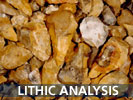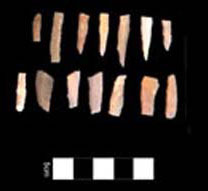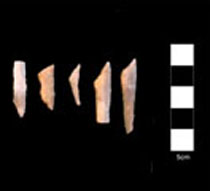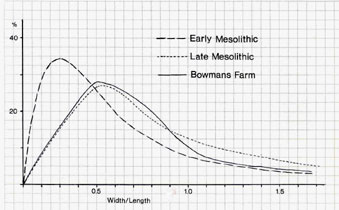|
Bowmans Farm The Bowmans Farm site (SU 33461700)
was discovered in June 1990 during a watching brief carried out by the
Test Valley Archaeological Trust (TVAT) for the construction of a pipeline
between Braishfield and Ower by British Gas Southern. The site consisted
of various features containing charcoal-rich fills in association with
scatters of mint condition lithic artefacts. Two pairs of penannular
ring-ditch features were found approximately 100m apart along the pipeline
(Houses 1–4). Analysis of the lithic material suggests a Late Mesolithic
date, with abundant tiny rod-shaped, quadrilateral and scalene triangle
microliths, and few other tools.
Fig.1a and b. Selection of Bowman's Farm microliths Further study of the lithic collection from Bowmans Farm, House 4, has confirmed its Late Mesolithic attribution. The majority of the knapping technology at the site is focused on the production of blades, the tool assemblage is dominated by scrapers, geometric microliths and burins, and a quantitative analysis of the dimensions of the debitage confirmed its similarities to other Late Mesolithic material from southeast England. Further study is required to clarify the relationship between the features and the artefact collection. The site is potentially of at least national significance as i) structural evidence relating to this period is extremely rare in Europe, and ii) the nature of the transition from the Mesolithic to the Neolithic has been highlighted by English Heritage (1991 Exploring our Past: 34–36) as a key research issue. Charcoal from the House 3 ring-ditch has been dated to 3,960±90 bc, or c. 4,800 BC (OXA-2631), at least 500 years earlier than the earliest known Neolithic occupation of southern England. Funding to complete analysis of the project archive and publish the results is still being sought.
|
|
 |
 |
 |
 |




